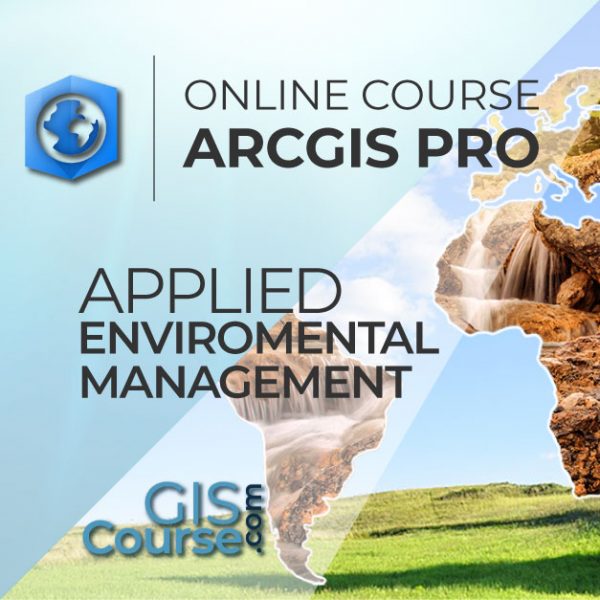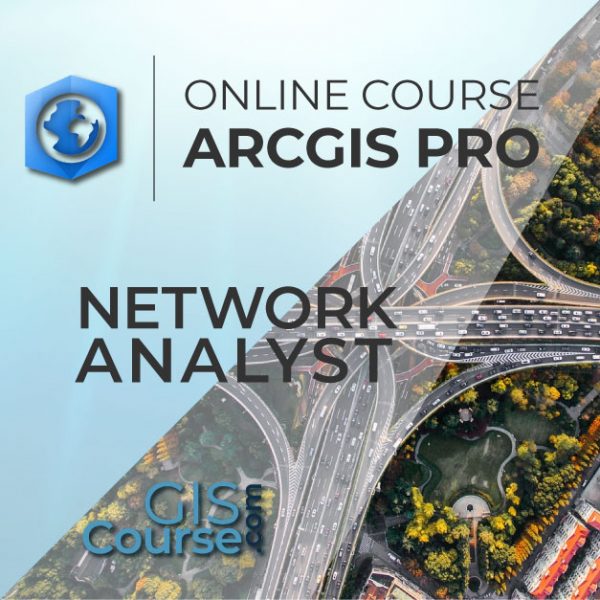ARCGIS PRO COURSE APPLIED TO GEOLOGY AND MINING
ONLINE TRAINING
START DATE: Available Soon
PRICE: 400€ (Standard fee) | 360€ (Student / Unemployed fee)

This course will qualify students in ArcGIS PRO, the new ArcGIS Desktop release, applying advanced GIS techniques to spatial analysis regarding mining activities, risk analysis, geological maps, project planning for mineral exploitation, decision making support, etc.
Students will gain knowledge in the usage of ArcGIS PRO software with application in geology and mining planning activities (environmental impact studies, environmental documents, mineral deposits estimation, etc.). They will master the creation of high quality maps, spatial multi-criteria analysis for mining activities management.
Enrolled students in this online course will have access to our virtual e-learning platform (which is available 24 hours), where they will find the content of the course, practical exercises, forum discussion and additional content. One of the advantages of this online platform, is that students can benefit of real time support and assistance offered by the instructor (2 hours per week), whom they can contact via direct messages, regarding course related issues, at any moment. They can also contact the instructor via email.
- Demonstrate the importance and practicality of GIS in engineering, geology, mining activities and environmental management studies.
- Understand all the essential concepts, needed for an advanced manipulation of ArcGIS PRO and GIS in general, along with practical application in environmental and mining activities management.
- Learn about GIS key tools used in the management of raster and vector data models, the creation of high quality cartography products and the development of complex spatial analysis.
- Find out about all the existing difficulties and solutions in the design of GIS environmental and mining activities studies through practical exercises.
- Prepare and edit your own data, develop your own layouts and high quality map products for environmental and mining activities impact studies, etc.
1 - INTRODUCTION TO GEOGRAPHIC INFORMATION SYSTEMS
- Introduction.
- Definition and basic concepts.
- Uses of Geographic Information Systems.
- Geographic information: vector data models, raster data models and other data models (CAD, TIN, etc.). Main features of each data module, advantages and disadvantages.
- Introduction to ArcGIS Pro.
- Arcmap interface, extensions and tools.
Verification of the correct functioning of the software and assessment.
2 - VECTOR DATA MODEL. INFORMATION DISPLAY
- Information layers: how to add layers, features and attribute tables.
- Data tools: search and queries.
- Selection tools: selection per feature, selection by spatial location and information capture.
- Layer symbology: basic symbology, by category, by quantity and through graphics.
- Other display options: labelling and transparencies.
3 - COORDINATE SYSTEMS, PROJECTIONS AND GEOREFERENCING
- Introduction to Coordinate systems and projections.
- Defining Coordinate Systems.
- Coordinate system transformation. Reprojection of ED50 or ETRS89 geographic databases.
- Image, layer and CAD files georeferencing.
4 - VECTOR DATA MODEL. EDITING AND CREATING INFORMATION
- Creation and editing of spatial data
– Creating spatial data: Editing tools bar. Digitization techniques
– Creating layers from CAD files
– Modifying existing layers
– Creating layers from coordinates and GPS data. - Creation and editing of data in attribute tables
– Structure of an Attribute Table
– Types of data included in an Attribute Table
– Modify information from an Attribute table
– Calculate geometric information (surface, perimeter, length, etc.)
– Creation of statistics from an Attribute table
– Export tables to Excel and other formats. Reports and graphs creation.
5 - DATABASE AND SPATIAL DATA BASE MANAGEMENT (GEODATABASE)
- Designing databases.
- Joining and relating databases.
- Spatial joins. Obtain statistics from database information and spatial position of elements in a layer.
- Geodatabase: Advantages. Properties.
- Loading data to the geodatabase. Subtypes and domains.
Guided exercise 1 (GIS database): Creation of digital cartography from field data.
6 - SPATIAL ANALYSIS USING VECTOR DATA
- Extract (Clip, Split), overlay (intersect, union) and proximity (buffer analysis, Thiessen polygons) toolsets.
- Obtaining field grids.
- Multi-criteria analysis. Obtaining optimum areas according to several criteria.
Guided exercise 2 (data analysis): Creation of grid fields and combining them with field data applied to geology.
7 - SPATIAL ANALYSIS USING RASTER DATA
- File conversion tools. File format conversion from vector to raster, and viceversa, ASCII or html files, and exporting files to KML (Google Earth) as well as CAD.
- Create Digital Elevation Models from vector data, ASCII files and TIN files.
- Extracting information from raster files by query, mask, entity and / or joining raster files.
- Contour lines, slope calculation, hillshade maps, orientations and visibility studies.
Guided exercise 3 (digital terrain model): Generating DTMs from vector and field data. Modifying DTMs.
Guided exercise 4 (landscape): Creating a visibility study through viewsheds from high precision digital terrain models, defining specific views and project elements.
8 - ADVANCED SPATIAL ANALYSIS
- Data interpolation. Different interpolation methodologies (IDW, kriging, natural neighbour).
Guided exercise 5 (Geochemical Maps): Generating geochemical maps depending on the spatial variability of chemical elements or compounds to detect anomalies (geological exploration), contaminated soils perimeter, etc.
- Use in hydrology: obtaining a drainage system, flow direction, outlets, and identifying drainage basins.
Guided exercise 6 (hidrology): Obtain the drainage network, the main flow direction, accumulation areas and hydrographic basins, sub basins and micro basins.
9 - ADVANCED SPATIAL ANALYSIS II
- Reclassifying raster files. Euclidean distances, building Boolean layers, adding values to intervals or categories, and data conversion.
- Map algebra (raster calculator), math calculations between raster layers and field statistics.
Guided exercise 7 (slope stability): Risk analysis for landslides according to several variables like slope, type of soil, presence of vegetation, etc.
- Volume calculation.
- Raster multi criteria analysis. Basic concepts and weightings. Weighted overlay. Non-compensatory analysis.
Guided exercise 8 (selection of alternatives): Multicriteria analysis to position a mine, including its sterile batteries.
10 - 3D DATA DISPLAY (ARCSCENE)
- Converting vector files from 2D to 3D.
- Vector and raster layers display in 3D.
- Generation of 3D figures in ArcGIS.
11 - WEB INFORMATION SOURCES AND RESOURCES
- Downloading digital maps (IGN) and using WMS cartographic servers.
- Regional, European and international Spanish spatial data infrastructure (IDEE).
- Arcgis Online Services.
12- MAP CREATION
- Sheet configuration.
- Inserting basic elements (north, scale bar, numeric scale, map legend, etc.)
- Adding UTM coordinates grid, composition with several “Data frames”, images, excel tables, etc.
- Save maps as templates. Create a document based on the template.
- Printing options.
Guided exercise 9 (map composition): Create quality mapping focusing on environmental studies according to the INSPIRE directive.

Santiago Pardini Hernanz
With Bachelor’s degree in enviromental sciences from Almeria University and master in engineering and enviromental management from escuela de organización industrial (EOI), Santiago is a professional in the GIS consultancy sector and remote sensing at TYC GIS Integral Solutions.
Santiago has diverse specialist courses in geographic information systems, remote sensing, CAD and BIM. He has more than 7 years experience in application of those technologies in enviromental consultancy, diverse engineering companies, Geomarketing, spatial plannin, etc.
COLLABORATOR

Mario Iglesias Martínez
Bachelor´s degree in Geological Sciences from the Universidad Complutense de Madrid and Hydrogeologist at the Universidad Politecnica de Catalunya, with a Master in Regional Geology and Geological Cartography at the Universidad Federal de Minas Gerais/ Brasil. With experience in geological cartography, hydrogeology and mining exploration in Spain, Brasil and sub-saharan Africa, he develops his work as a geologist in public organizations (Spanish Geological and Mining Institute), volunteering projects (World Geologists in Burkina Faso) and in different Engineering and Environmental Management consulting companies (MDGeo, CRN, etc). He currently is the Geologist – Project Manager of the mining exploitation authorizations that the Spanish company Cratón del Congo Exploraciones SL holds in Gabon and Mozambique.
Why study ArcGIS Pro?
The use of Geographic Information Systems (GIS) is growing rapidly and it is becoming an essential tool in a variety of sectors (engineering, environment, geography and mining), including new sciences like geomarketing. Among GIS tools, ArcGIS Pro is proclaimed as the program par excellence due to its stability, versatility and expansion, being the most used GIS software around the world.
Do I need previous knowledge in ArcGIS Pro?
No, the training course starts from the very beginning.
I don’t have the ArcGIS Pro program. What can I do?
Esri (creators of the ArcGIS program) provides a free licence for a 2 month trail. You only need to create an account, download the program and follow the installation steps (visit their website). Nevertheless, we are available to solve any problem you may have.
The online format uses the online learning and technological platform Moodle, a telematics tool that works through the internet. It is a learning platform that provides students access to the training course content, fulfill the practical cases and consult the teaching staff, as well as availability to the resources and help at any moment.
The platform is available 24 hours a day, through which the student will be able to ask for help at any given moment. Instructors will reinforce the student´s autonomy during its training process, supporting and clarifying any possible doubts that may arise along the course.
Therefore, the course is carried out through different areas available on the online platform and where the student can search for training material, download information, complete the practical exercises and take assessments to verify the assimilated knowledge. Teachers will offer progressively the basic information needed to work towards the completion of a final practical case.
500€ (Standard fee) / 450€ (Student / Unemployed fee)*
*To enjoy this discount, you must include a copy of a document that proves your situation along with the registration form.
** Si desea conocer el precio en otras monedas, puede consultarlo en el siguiente conversor online: The Money Converter

1st step. Request your registration to the training course completing the pre-registration document and sending it via email to training@tycgis.com.

2nd step. As soon as we receive it, we will send you an enrolment guide with the complete information to enrol in the course: dates, schedule, software needed for the course and the installation guide. The payment methods are included in this document.

4rd step. Once we receive the receipt, we will confirm your registration to the course via email.

NATIONAL WIRE TRANSFERS (INSIDE SPAIN):
ACCOUNT NUMBER: 0049 1809 222710347481 (Banco Santander)
BENEFICIARY: TYC GIS Soluciones Integrales SL
SUBJECT: “Student Name” and GIS GEO PRO COURSE ON
INTERNATIONAL WIRE TRANSFERS:
BANK NAME: Banco Santander
BANK ADDRESS: Glorieta Ruiz Jiménez 1, 28015 Madrid (España).
BENEFICIARY: TYC GIS Soluciones Integrales SL
BENEFICIARY ADDRESS: Calle Fuencarral 158, Entreplanta, Oficina 16-17 28010 Madrid (España).
ACCOUNT NUMBER: ES90 0049 1809 222710347481
SWIFHT: BSCHESMM – IBAN: ES90
If you have payment difficulties, contact us






 (9 votes, average: 3.56 de 5)
(9 votes, average: 3.56 de 5)


